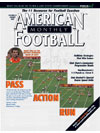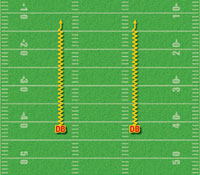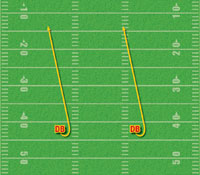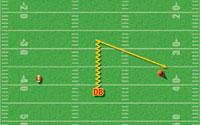AMERICAN FOOTBALL MONTHLY THE #1 RESOURCE FOR FOOTBALL COACHES
Article CategoriesAFM Magazine
|
D-Backs: Playing with Low Pad LevelIowa State stresses The Importance of Pad Level and the Use of the Cage to help give their secondary power at the point of contactby: Jeff Koonz Secondary Coach, Iowa State University © More from this issue One of the most important fundamental concepts that we stress in the secondary at Iowa State University is playing with low pad level. We believe as a staff that this improves the capabilities of our players in two ways. First, low pad level allows us to have phenomenal power when striking a ball carrier or when disengaging from a blocker. Second, it allows for quicker cuts and breaks, especially within the secondary. I have had the opportunity to work with both the linebackers as well as the defensive backs in our system, and I believe that playing with low pad level is equally important to both positions. Some believe that taking players out of a comfort zone and forcing them to play low is counter productive. I believe that playing with low pad level is a teachable technique that can be made comfortable over time and has extensive benefits to merit its attention in individual/fundamental periods during practice. Defensive backs tend to play high because of their natural stand-up stance. It is because of this tendency that we spend much of our fundamental time during practice under what we call ‘the cage.’ The cage is square in shape and it measures approximately 12 feet by 12 feet. We have our cage set at approximately 55-60 inches in height. Now you may be thinking to yourself, ‘This sounds great, but my budget doesn’t allow for $500 to buy a cage.’ Perhaps the best part of the cage is that anyone can make one. I’ve seen cages made out of PVC pipe and chicken wire. Anything that enables your athletes to work fundamentals under a constricted height is beneficial. Before arriving at Iowa State, I had never used the cage when teaching technique to the defensive backs. However, after teaming up with Shawn Raney in the secondary, we began discussing some drills that he had done in the past with the defensive backs under the cage, along with some drills that I had done in the past with linebackers. Finally we added some different ideas that we thought would be good to try through the course of spring ball. Our safeties began each practice with what we call the cage circuit. This circuit is used as a fundamental warm-up. Within this circuit they perform three fundamental movements that a safety must do within our system. We will use the square cage for this circuit and the safeties will go two at a time, side by side. First the two will do a controlled backpedal out the back side of the cage (See Diagram 1). This movement teaches low pad level in the stance and the start of the backpedal motion. Second, the two will work what we call a ‘quarter turn’ technique where on the snap the safety is opening to the wide receiver and doubling that receiver along with the corner (See Diagram 2). The motion should look like a ‘bounce turn’ technique in place, with the safeties finishing the movement by running out the backside of the cage. This simulates the safety running underneath a post route. The safeties will finish the circuit by going one at a time and working deep middle thirds coverage rolls. We base out of a two deep shell. Our initial footwork when we roll the middle of the field is a controlled shuffle at a 45 degree angle to read run or pass (See Diagram 3). We simulate this under the cage by having the safety shuffle three times, followed by a crossover turn and run out the backside of the cage. Once the safety clears the edge of the cage, he will square into a backpedal.
At least five minutes a day during individual periods we will put both the safeties and corners through different breaking drills underneath the cage. Shawn and I are always trying to simulate all of the movements that are possible within our scheme. We begin the cage work with a shuffle technique and break (See Diagrams 4, 5, and 6). We will break the guys at different angles so that they are working on upfield breaks (slant/post), down hill breaks (hitch), and across the body breaks (out cut). Then we will simulate the same breaks out of an initial backpedal rather than shuffle. Within all of these breaks from underneath the cage, we always stress an accelerated and definitive finish out of the cage. We found that doing these different breaks under the cage dramatically improved the technique and quickness of our defensive backs through the course of spring practice. We definitely plan on continuing to use them throughout the course of the upcoming season.
|
|
| HOME |
MAGAZINE |
SUBSCRIBE | ONLINE COLUMNISTS | COACHING VIDEOS |
Copyright 2024, AmericanFootballMonthly.com
All Rights Reserved










